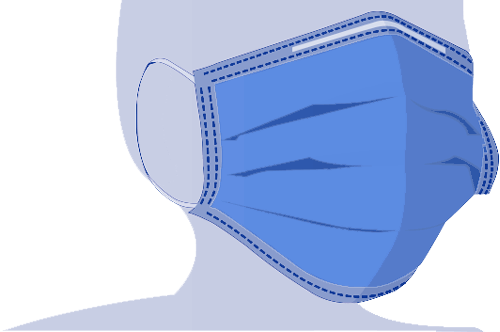
¡Seguimos cuidando tu salud! Recuerda: el uso de cubrebocas es obligatorio durante tu estancia en el hospital; con esto evitamos la propagación de enfermedades respiratorias.

¡Seguimos cuidando tu salud! Recuerda: el uso de cubrebocas es obligatorio durante tu estancia en el hospital; con esto evitamos la propagación de enfermedades respiratorias.
Also known as a contrast material or agent, the substance is administered internally in the body to improve pictures obtained by X-rays, computed tomography, magnetic resonance imaging (MRI) and ultrasound.
The role of contrast materials is to help doctors diagnose accurately, abnormalities or diseases that may present in the patient.
The three main ways in which a contrast material can enter the body, are divided into:
After the exam, the material is absorbed by the body or eliminated through urine or bowel movements.
Types
Exams
1. Oral contrast materials
The barium sulfate contrast material is swallowed or given orally and is used to enhance X-ray and CT images of the gastrointestinal tract. This test is applied to body parts such as the pharynx, esophagus, stomach, small intestine and large intestine.
2. Rectal contrast materials
In these tests, the barium sulfate is also administered via enema (through the rectum) is used to enhance X-ray and CT images of the lower gastrointestinal tract (colon and rectum).
3. Intravenous contrast materials
To perform this type of exam, iodinated and gadolinium materials are injected, which improve the images of internal organs (heart, lungs, liver, adrenal glands, kidneys, pancreas, gallbladder, spleen, uterus, and bladder), the gastrointestinal tract (stomach, small intestine and large intestine), arteries and veins of the body (vessels of the brain, neck, chest, abdomen, pelvis and legs), soft tissue (muscles, fat and skin), brain and breast.
Procedures
Because contrast materials have a risk of allergies or adverse reactions, you should inform your doctor about:
You will be given specific instructions on how to prepare for your exam.
Side Effects
1. Barium Sulfate
You may have the following side effects. You should tell your doctor, in case they worsen or do not disappear:
Likewise, notify your doctor immediately about any of these symptoms:
2. Iodinated material
You may have the following side effects. You should tell your doctor, in case they worsen or do not disappear:
Mild reactions include: severe irritation of the skin or hives, wheezing, abnormal heart rhythms, high or low blood pressure, shortness of breath or difficulty breathing.
Severe reactions include difficulty breathing, heart failure, swelling of the throat or other parts of the body, seizures and abnormally low blood pressure.
3. Contrast Induced Nephropathy
Patients with compromised renal function should be given special consideration before receiving iodinated contrast material into a vein or artery. Such patients are at risk of developing contrast-induced nephropathy, which worsens pre-existing damage in the kidney.
Anesthesia
Anesthesia involves the use of anesthetics that cause loss or reduction of sensation in the body. These drugs are used to help patients better tolerate medical and surgical procedures.
The types of anesthesia that are currently divided in two:
Local anesthesia can be administered topically, applied to the surface of the skin in a cream or an adhesive patch; epidural, an administered injection that causes loss of sensation by blocking nerve transmission at or near the spine, is used to block the movement of the waist to the toes.
For its part, spinal anesthesia involves the injection of an anesthetic into the fluid-filled space surrounding the spinal cord.
General anesthesia is achieved by administration of inhaled gases and the patient will not remember having had any medical procedure. It should be noted that the patient is not breathing on their own, they requires a machine called anesthesia ventilator.
Sedation
Sedatives are medications that alter the consciousness of a patient to minimize pain, anxiety and discomfort that may be caused by undergoing surgery, and you may or may not remember the medical procedure.
There are two levels of sedation:
Imagine procedure with Anesthesia
* In general, anesthesia and sedation are safe for most patients. Patients are carefully monitored when receiving any anesthetic, including sedation.
Side effects and allergic reactions
When anesthesia is administered by injection, the patient may feel numbness or tingling for a few days, and for epidural analgesia, they may experience headache.
The most common complications after general anesthesia are: nausea, vomiting, minor allergic reactions, dizziness, headache, sore throat, changes in blood pressure and pain. Easily treated with medication.
The most serious complications that may arise are: allergic reactions, strokes and heart attacks.
The patients most likely to develop problems due to anesthesia are those with:
Pregnancy
Before any imaging study, women should always inform your doctor if they are pregnant, since many of the imaging tests cannot be performed in that state.
Only if very necessary for a surgical procedure, anesthesia can be administered with care to protect the fetus and the mother.
For their part, women who are breastfeeding can receive normal doses of local anesthetics without affecting their child, but should consult their doctor before taking any medication that could be passed to the baby when breastfeeding.
Información sujeta a cambio sin previo aviso 11/AGO/2025 LFAL
Do you live outside Mexico?
We give you advice and support for your travel and stay al Médica Sur
Toll free: 800.501.0101
Canada / USA: 1877.213.6659
24 hours everyday